Comprehending the Causes and Solutions for Undercut Welding in Steel Construction Procedures
In the world of steel construction processes, the event of undercut welding postures a significant challenge that requires a comprehensive understanding of its reasons and sensible remedies. The detailed interaction of numerous factors during welding procedures can bring about this unwanted sensation, affecting the structural integrity and total top quality of the bonded joints - Preventing weld undercut. By dissecting the root creates of undercut welding and discovering efficient remedial measures, makers can boost the requirement of their workmanship and ensure the production of flawless steel elements
Common Causes of Undercut Welding
Often forgotten in steel fabrication, undercut welding occurs due to different aspects that require thorough attention and know-how to be effectively reduced. Additionally, incorrect welding methods, such as making use of the wrong welding angle or take a trip rate, can additionally contribute to damage formation. The selection of welding criteria, such as voltage, current, and wire feed speed, plays a substantial function in the event of undercut welding.
Influence of Incorrect Welding Parameters
Incorrect welding criteria can significantly endanger the integrity and quality of welded joints in metal fabrication processes. The effect of inaccurate welding criteria materializes in various methods, causing architectural weaknesses and issues in the welded parts. One essential facet impacted by inappropriate welding specifications is the infiltration depth of the weld. Inadequate warmth input as a result of reduced welding currents or excessively high traveling rates can lead to insufficient fusion in between the base metals, leading to incomplete joint penetration and weakened bonds. Conversely, too much heat input caused by high welding currents or slow-moving travel speeds can bring about too much and burn-through support, creating a weak and unstable weld framework. Additionally, inaccurate criteria such as improper voltage settings or wrong electrode angles can add to irregular weld bead profiles, absence of combination, and boosted chances of defects like undercutting. Consequently, thorough focus to welding criteria is critical to make sure the manufacturing of top quality welds with the preferred mechanical residential properties and structural stability.
Effect of Improper Torch Angle
Inappropriate lantern angle in welding procedures can significantly impact the quality and integrity of the final weld joints in steel manufacture procedures. The lantern angle plays an essential duty in determining the heat input and distribution during welding. When the lantern angle is wrong, concerns such as damaging can develop. Undercutting is a typical welding flaw where a groove forms along the weld toe, weakening the joint and endangering its architectural honesty.
A lantern angle that is as well steep can lead to not enough infiltration, incomplete fusion, and raised spatter. On the various other hand, a torch angle that is too superficial can lead to extreme penetration, burn-through, and distortion of the base product. Preventing weld undercut. Appropriate torch angle is essential for ensuring regular weld high quality, strength, and look
To stop damaging and other issues triggered by improper lantern angles, welders should be trained to preserve the appropriate lantern angle throughout the welding process. Normal tracking and adjustment of lantern angles during welding can aid accomplish sound welds with very little defects.
Duty of Inadequate Welding Techniques

An additional element of insufficient welding methods is inappropriate weld preparation. Insufficient cleaning of the base metals, incorrect joint style, or insufficient edge prep work can all contribute to damage welding. Poor securing gas insurance coverage or utilizing the wrong type of gas can result in insufficient fusion and the development of undercut problems.
To attend to the duty of insufficient welding techniques in metal fabrication procedures, it is necessary to give comprehensive training for welders. Appropriate education and learning on welding parameters, joint preparation, and shielding gas option can assist prevent undercut welding and ensure high-grade welds in steel fabrication tasks.
Effective Solutions for Undercut Welding
Addressing undercut welding in steel fabrication calls for executing reliable services to boost weld high quality and structural honesty. One of the key services to combat undercut is to change welding criteria such as voltage, present, and take a trip speed to make sure proper warm input and blend. By fine-tuning these settings, welders can avoid excessive melting of the base metal and filler material, lowering the possibility of undercut development.
Additionally, appropriate joint prep work is essential in protecting against undercut. Ensuring clean base steel surface areas devoid of contaminants and using the suitable bevel angle can help advertise better weld penetration and lower the risk of undercut - Preventing weld undercut. Utilizing appropriate welding strategies, such as weaving or oscillating the lantern, can also help in dispersing warmth evenly and filling the weld joint appropriately, reducing the possibility of undercut flaws
In addition, picking the correct welding consumables, including electrodes and filler steels, is important in alleviating undercut. Utilizing products with ideal chemical make-ups and mechanical residential properties can add to attaining audio welds with minimal undercut. Regular over at this website inspection and quality control measures must likewise be carried out to identify and resolve undercut concerns without delay, making certain the total honesty of made metal elements.

Conclusion
To conclude, understanding the causes and services for undercut welding in metal manufacture procedures is critical for attaining top notch welds. By attending to typical causes such as wrong welding specifications, incorrect torch angle, and poor welding techniques, welders can stop damaging and make certain solid, long lasting welds. It is vital navigate to this site to pay attention to these aspects and carry out reliable options to enhance the overall welding process and last product quality.

Comments on “Ideal Practices for Preventing Weld Undercut: Understanding the Essentials”